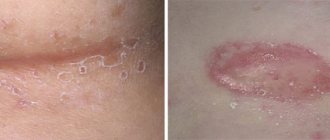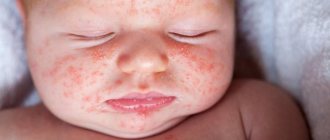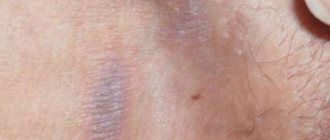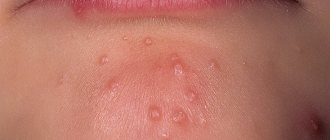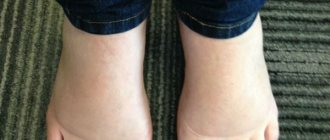Pediatrician
Sayfulina
Maryam Zakareevna
32 years of experience
Pediatrician of the highest category, member of the Union of Pediatricians of Russia
Make an appointment
Miliaria in children under one year of age and older is a fairly common skin lesion, which is a rash caused by severe sweating or poor care of the child’s delicate skin. It is important to understand that the baby’s thermoregulation processes are not yet perfectly established, and therefore the slightest negative factors can cause an undesirable reaction - parents should not be scared and think that this is a rare phenomenon. Almost all kids go through this.
However, you shouldn’t treat this problem negligently either: ordinary heat rash without treatment tends to become more complicated and worse, and in this case, longer and more complex treatment will be required - it’s better not to let it get to that point.
Symptoms
Symptoms of prickly heat in children include:
- The appearance of a characteristic rash on the neck, in the ear area, on the back of the head, along the hairline, armpits, in the upper chest, as well as on the back, in the groin folds and on the buttocks.
- Small rashes in the form of bubbles with transparent contents. In more complex cases, these are reddish nodules with an inflamed rim. The rash reacts to temperature, so it can decrease or increase depending on the environment.
- Weeping lesions - they occur when there is extensive damage to the skin.
- Pustules, swelling, redness of the skin and a putrid odor. This is not so much a symptom of prickly heat in children, but a signal that a bacterial or fungal infection has joined it.
- Soreness, itching and other unpleasant sensations that cause anxiety in the child make him capricious. This is not observed with ordinary heat rash, but if the condition is complicated, such negative factors will progress, simultaneously causing an increase in body temperature.
At any stage of heat rash in a child, even if it is very mild, it is necessary to consult a pediatrician. If complications arise, you should immediately consult a doctor - such issues are dealt with either by a pediatrician or a pediatric dermatologist.
Causes
The main cause of heat rash in a child is overheating, and it is caused by various factors, including:
- Too warm, and synthetic clothes at that.
- Untimely changing of diapers, especially in hot weather or in a warm room.
- A minimal amount of air baths and infrequent bathing, due to which the skin is not cleansed and does not breathe.
- Using cosmetics that are too oily and thick on the skin, which does not allow heat to be released properly.
- Diseases associated with fever. Especially if parents also use warming treatment methods.
To overheating we will add such factors as allergies to various materials, friction and pressure of clothing, effect on irritated areas of feces and urine.
It may seem that the causes of heat rash in children are due solely to parental care errors, but this is absolutely not the case. There are children who themselves are prone to developing this condition. These are allergy sufferers, overweight children, children with various endocrine diseases (for example, diabetes). Also at risk are formula-fed children and premature newborns. When caring for such babies, you should be especially attentive to the condition of the skin and body.
Diaper rash in infants: treatment and prevention
13.12.2021
The skin of a newborn baby is extremely sensitive, and the most susceptible to irritation is the area of the diaper, which is inaccessible to air and is also constantly wet, and contact with irritating chemicals in urine and stool, as well as friction of the diaper on the skin, becomes a prerequisite for the appearance of diaper rash in the area of the baby’s buttocks.
The lipid protective layer of a baby's skin is not yet fully formed, so irritation, chafing and dermatitis . Any redness noticed should be alarming, as it can quickly progress to diaper rash or diaper rash .
Diaper dermatitis is characterized by the appearance of skin rashes in places where the diaper fits tightly - most often the buttocks, groin, genital , lower abdomen . The first symptoms are erythema and peeling of the epidermis; in subsequent stages, red spots, papules, blisters or erosions appear. The child becomes irritable, whiny and nervous.
Diaper rash in newborns and infants most often occurs as a result of wet skin under the diaper and too much skin contact with urine or feces. Sensitive skin is irritated by ammonia produced when bacteria decompose. When the skin is damaged and inflammation develops as a result of irritants, secondary fungal (especially yeast) or bacterial infections often occur. Under the influence of bacteria, urine becomes more alkaline, which further increases its irritating effect on the skin, and an increase in pH promotes the further development of bacteria. The risk of diaper rash in a newborn is higher when the environment is hot (summer). In addition, the appearance of diaper rash in children is facilitated by a predisposition to an allergic reaction , for example, to the material of the diaper or certain substances used to care or treat this area, as well as the use of low-quality diapers.
Factors contributing to the formation of diaper rash
- Not changing diapers often enough
- use of unsuitable baby skin care products
- using excessive amounts of creams and powders
- infrequent washing and airing of the baby’s buttocks
- unsuitable irritants used for washing diapers
- changes in stool composition due to food changes or antibiotic therapy
- heat
- skin is prone to allergies
What does diaper rash look like in babies?
The first thing parents notice when changing a diaper is redness of the skin around the anus , intimate areas or groin. Redness may be accompanied by swelling and the release of serous fluid. The skin is warmer and very sensitive to touch. The baby is restless, experiencing discomfort, burning and pain.
Diaper rash in children can lead to bacterial and fungal dermatitis . In just a few hours, if not noticed or taken care of properly, diaper rash can turn into dermatitis . Its symptoms:
- no improvement in the condition of the child’s skin
- the rash enlarges and extends beyond the diaper
- peeling skin
- temperature increase
Airing is the best way to get rid of diaper rash. It is necessary to remove the diaper and allow the child to lie naked for as long as possible (a few hours a day, but shorter times will also be beneficial). Of course, this procedure is easier to perform if the child is not yet very actively moving and does not change position on his own, because such a baby just needs to be placed on a sanitary pad or a folded diaper - thanks to this, you can avoid staining the blanket or bed linen. The best time to ventilate the buttocks is when the baby has just had a bowel movement.
What will speed up the fight against diaper rash?
It is definitely worth using water instead of napkins - clean, without soap (and if you cannot do without soap, at least it should be soap intended for babies). Washing your baby's skin too often or too aggressively with soap or wearing diapers that are too small (or too tight) will result in insufficient air flow. As a result, the problem only gets worse.
Diaper rash ointment for babies can be applied to irritated skin. Effective ointments that prevent the penetration of urea into the skin include: zinc ointment, petroleum jelly. Before applying any product, it is important to thoroughly cleanse the skin and then dry it.
Potato flour is also good for rubs. It also has three additional advantages: firstly, it is completely natural and does not contain any chemicals, secondly, it is cheap, and thirdly, it is easily available. The use of talc-based powders is not recommended.
Babies with allergies , a hereditary tendency to diaper rash, a pH imbalance (improper balance between acidity and alkalinity), or babies with higher than normal levels of ammonia in their urine are especially prone to a recurrence of this condition. Once irritated and at the same time extremely sensitive, a child’s skin is more prone to subsequent relapses.
Published in Pediatrics Premium Clinic
Diagnostics
A pediatric dermatologist or pediatrician will examine the child and interview the parents, as well as a series of studies to rule out dermatitis, chickenpox, scarlet fever and many other diseases with similar symptoms. Most often, a visual examination is enough, but tests (scraping) may be required to help identify the causative agent of a secondary infection (if one is observed). A general and biochemical blood test is often done, as well as an analysis of the contents of the vesicles - it all depends on the recommendations of the attending physician.
Treatment
Usually, treatment of prickly heat in a child is carried out comprehensively and includes the following points:
- Maintaining optimal temperature in the house - no more than 20-22 degrees Celsius. The same goes for humidity, which needs to be monitored - 50-70%.
- The right choice of clothes. It must be appropriate for the temperature and not be synthetic or too dense.
- Regular hygiene procedures - washing, bathing using gentle cosmetics designed specifically for children's delicate skin.
- Regular diaper changes. Your baby's skin should always be clean and dry.
- Use of medications and other means prescribed by a doctor. Sometimes decoctions of medicinal herbs are allowed, but only when the doctor allows it. For the rest, specially selected ointments, powders and other medications are used. In difficult cases, antifungal drugs and antibiotic-based ointments can be used - but parents should not purchase such products on their own.
As a rule, when prickly heat appears in a child, the prognosis is good. After establishing hygiene procedures, the problem disappears quite quickly. If the baby’s immunity is severely weakened, and a dangerous infection develops against the background of prickly heat, there is a risk of complications. In this case, the treatment will be longer and more complex, and in exceptional cases it will require hospitalization of the child.
If your baby exhibits symptoms of infant heat rash, do not wait until complications begin - be sure to contact pediatricians or dermatologists at Meditsina JSC - get examined by a doctor, get an accurate diagnosis and an effective treatment plan.
What you should never do if you have heat rash in a child
Before visiting specialists, many parents try to help their child on their own and use various tips from the Internet. This should not be done under any circumstances. We have compiled a short list of what is prohibited:
- Squeeze and open the blisters on the baby’s skin.
- Cover inflammations and blisters with iodine or brilliant green, as well as other aggressive agents.
- Moisturize the skin with any available means. Heavy moisturizing creams are often used, which in this case are strictly contraindicated.
- Dry wet areas with rough materials or sudden movements. If it is necessary to remove moisture, this is done with very clean, soft and highly absorbent material - with extremely careful and smooth movements.
But it is best to immediately visit a doctor and get detailed advice about what you can and cannot do.
Redness caused by fungi
Redness under the arms can be the result of a fungal skin infection called tinea capitis. Most often, this is candidiasis-dermatomycosis, caused by yeast of the genus Candida (most often Candida albicans). They are an integral part of a healthy body, but can cause problems if they multiply excessively. This occurs when the body’s immune defense is weakened (stress, exhaustion, antibiotics).
An important role in the development of these skin changes is played by local damage to which candida easily “attaches.” The fungus then manifests itself as an infection that affects the entire body (systemic infection) or specific parts of it, such as nails, skin, scalp or mucous membranes (vaginal candidiasis, candidiasis of the digestive system, skin infection - ringworm).
Most often, ringworm occurs in skin folds, under the arms, on the chest and in the groin. It begins with mild itching, followed by redness, cracking, and marginal peeling of the skin. It is treated with antifungal creams under the supervision of a dermatologist.
To prevent the development of dermatomycosis, it is necessary to keep the areas of skin folds clean and dry, since moisture promotes the growth of fungi. Fungal infections are also more common in areas where there are large numbers of people, such as schools, daycare centers and swimming pools. Therefore, after visiting public areas, it is recommended to take a shower and dry thoroughly with a towel so that moisture does not get into the armpits and other folds of the skin.
